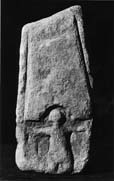Select a site alphabetically from the choices shown in the box below. Alternatively, browse sculptural examples using the Forward/Back buttons.
Chapters for this volume, along with copies of original in-text images, are available here.
Object type: Part of cross-shaft
Measurements: H. 44.5 cm (17.5 in); W. 24.2 > 17.2 cm (9.5 > 6.75 in) D. 15.9 > 13.4 cm (6.25 > 5.25 in)
Stone type: Coarse-grained, bedded red/yellow sandstone
Plate numbers in printed volume: Pl. 159.824-827
Corpus volume reference: Vol 1 p. 165-166
(There may be more views or larger images available for this item. Click on the thumbnail image to view.)
The shaft tapers sharply and is deeply carved in a grooved technique.
A (broad): This is surrounded by a plain roll moulding on the same level as the plain-dressed panel in the upper half. In the lower half the stone has been cut back to form the outline of a figure. The body, which survives to the thighs, is upright and frontal; the arms are extended, and the body appears to be clothed in a short tunic.
B (narrow): Traces of a cable moulding survive on the left edge of the shaft. (i) A small strip of meander pattern 2, set horizontally. (ii) A panel of three-strand plain plait, deeply cut and with an irregular terminal.
C (broad): A heavy cable moulding survives on the left side; the right is broken but also cabled. Two strips of step pattern 1 enclose a bold meander pattern 2, six elements of which remain.
D (narrow): A panel of deeply cut three-strand plain plait, irregular in parts; the shaft was originally edged by a moulding but it is now too worn to identify.
This shaft is unique among the Bothal pieces in the depth and competence of its carving and the smoothness of its dressing. In shape it is similar to the so-called Tidfirth stone from Monkwearmouth (no. 3). which has figures on one face. The figure on face A here doubtless represents Christ crucified. Step and meander patterns were popular in the Viking period, and the depiction of the Crucifixion without the cross also seems to be a late feature (Coatsworth 1973).



